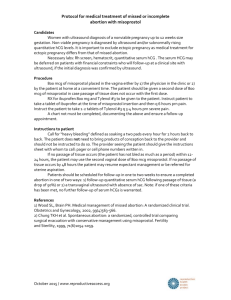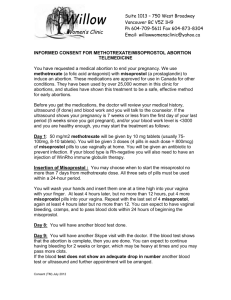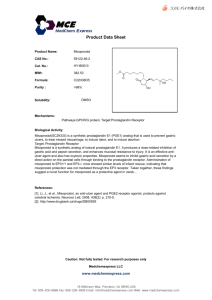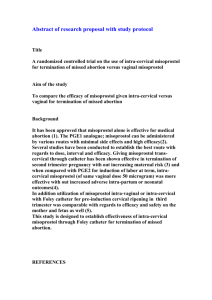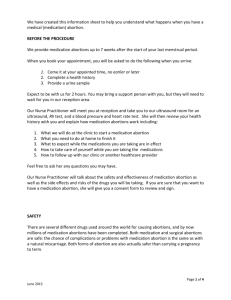Dr. B. Shilpa Shivanna - journal of evolution of medical and dental
advertisement
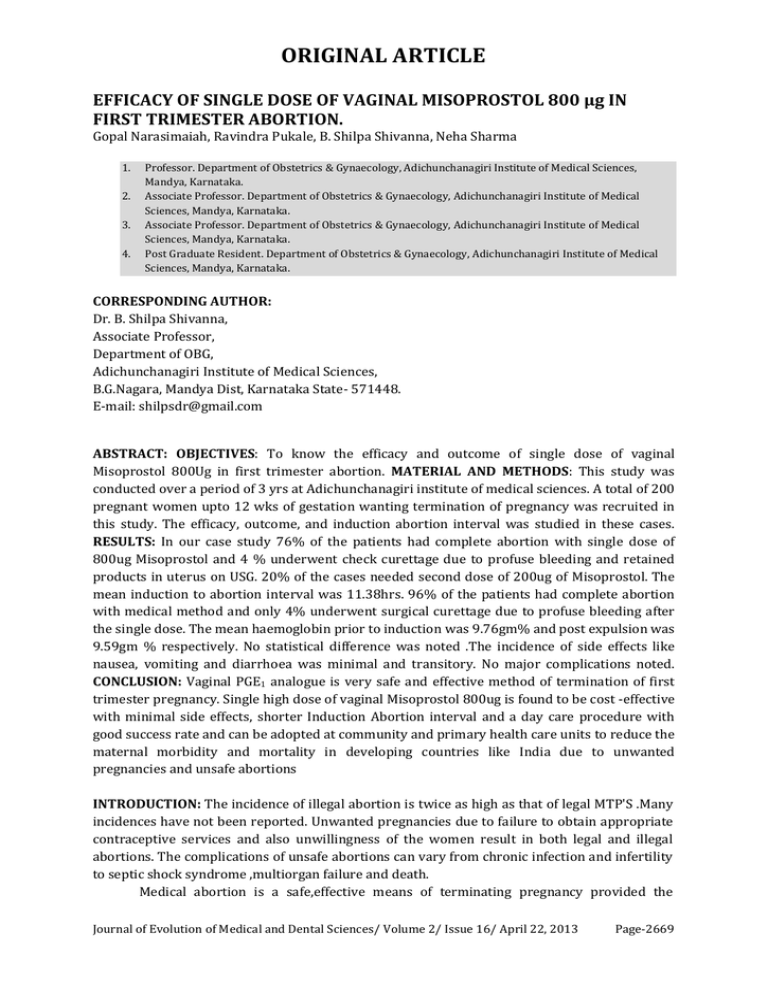
ORIGINAL ARTICLE EFFICACY OF SINGLE DOSE OF VAGINAL MISOPROSTOL 800 µg IN FIRST TRIMESTER ABORTION. Gopal Narasimaiah, Ravindra Pukale, B. Shilpa Shivanna, Neha Sharma 1. 2. 3. 4. Professor. Department of Obstetrics & Gynaecology, Adichunchanagiri Institute of Medical Sciences, Mandya, Karnataka. Associate Professor. Department of Obstetrics & Gynaecology, Adichunchanagiri Institute of Medical Sciences, Mandya, Karnataka. Associate Professor. Department of Obstetrics & Gynaecology, Adichunchanagiri Institute of Medical Sciences, Mandya, Karnataka. Post Graduate Resident. Department of Obstetrics & Gynaecology, Adichunchanagiri Institute of Medical Sciences, Mandya, Karnataka. CORRESPONDING AUTHOR: Dr. B. Shilpa Shivanna, Associate Professor, Department of OBG, Adichunchanagiri Institute of Medical Sciences, B.G.Nagara, Mandya Dist, Karnataka State- 571448. E-mail: shilpsdr@gmail.com ABSTRACT: OBJECTIVES: To know the efficacy and outcome of single dose of vaginal Misoprostol 800Ug in first trimester abortion. MATERIAL AND METHODS: This study was conducted over a period of 3 yrs at Adichunchanagiri institute of medical sciences. A total of 200 pregnant women upto 12 wks of gestation wanting termination of pregnancy was recruited in this study. The efficacy, outcome, and induction abortion interval was studied in these cases. RESULTS: In our case study 76% of the patients had complete abortion with single dose of 800ug Misoprostol and 4 % underwent check curettage due to profuse bleeding and retained products in uterus on USG. 20% of the cases needed second dose of 200ug of Misoprostol. The mean induction to abortion interval was 11.38hrs. 96% of the patients had complete abortion with medical method and only 4% underwent surgical curettage due to profuse bleeding after the single dose. The mean haemoglobin prior to induction was 9.76gm% and post expulsion was 9.59gm % respectively. No statistical difference was noted .The incidence of side effects like nausea, vomiting and diarrhoea was minimal and transitory. No major complications noted. CONCLUSION: Vaginal PGE1 analogue is very safe and effective method of termination of first trimester pregnancy. Single high dose of vaginal Misoprostol 800ug is found to be cost -effective with minimal side effects, shorter Induction Abortion interval and a day care procedure with good success rate and can be adopted at community and primary health care units to reduce the maternal morbidity and mortality in developing countries like India due to unwanted pregnancies and unsafe abortions INTRODUCTION: The incidence of illegal abortion is twice as high as that of legal MTP'S .Many incidences have not been reported. Unwanted pregnancies due to failure to obtain appropriate contraceptive services and also unwillingness of the women result in both legal and illegal abortions. The complications of unsafe abortions can vary from chronic infection and infertility to septic shock syndrome ,multiorgan failure and death. Medical abortion is a safe,effective means of terminating pregnancy provided the Journal of Evolution of Medical and Dental Sciences/ Volume 2/ Issue 16/ April 22, 2013 Page-2669 ORIGINAL ARTICLE criterias are fulfilled. Hence acceptable in both the developing and developed countries of the world. The usage of pharmacological agents such as Mifepristone, Misoprostol or in combination in various regimens is adopted for MTP. MISOPROSTOL, a PGE1 analogue is the prostaglandin of choice as it is easily available , cost effective and stable at room temperature. The use of Misoprostol alone at community and primary care levels has the potential to significantly increase the access to safe abortion and reduce the maternal morbidity and mortality. METHODS: A total of 200 pregnant women with a period of amenorrhoea of upto 12 weeks were recruited in the OPD among women requesting termination of pregnancy at Adichunchanagiri institute of medical sciences , B.G. Nagar, Mandya dist. over a period of 3 yrs. Volunteers who had missed their periods with a) normal general and gynaecological examination, b) intrauterine pregnancy confirmed by USG assessment .Exclusion criteria included : 1) history or evidence of illness that represent a contraindication to use Misoprostol heart disease, hypertension, Bronchial asthma , 2) history or evidence of Thromboembolism , 3) Severe or recurrent liver disease or pruritis of pregnancy, 4) Presence of intrauterine contraceptive device in uterus, 5) known allergy to Misoprostol, 6) scarred cervix or any previous cervical surgery 7) Previous scar on the uterus. The women were informed about the study , drugs to be used and their known side effects. Their informed written consent was obtained. The study was approved by the local hospital ethics committee. All the women were admitted to day care ward at the hospital. Basic investigations carried out. After examining the patient ,she was put in dorsal position and under aseptic precautions 800 µg of Misoprostol wet in normal saline was placed in the posterior fornix. Patient was instructed to stay in bed for 30mins post insertion. Thereafter women were monitored hourly for pulse rate, blood pressure ,temperature , occurrence of side effects such as abdominal pain, vaginal bleeding ,nausea, vomiting and signs of process of expulsion of conceptus for 12 hrs. If no progress was detected, second dose of 200ug of Misoprostol was kept in the posterior fornix and further monitored. The primary outcome measure was the complete abortion rate defined as successful cases that did not require surgical intervention. Failure was defined as the recourse to surgical as a result of method failure confirmed by USG assessment for retained products after 4 hrs after expulsion of products of conception. The changes in the haemoglobin and haematocrit values after 48hrs post expulsion, interval between initial dose of Misoprostol , bleeding and passage of products of conception were also noted. All study subjects were followed up at one month and three month intervals to obtain information with regard to general status , infections and menstrual regularity. Statistical analysis were performed using frequencies , chi - square test, paired - samples and T test. RESULTS: Table 1 summarizes the demographic characteristics of 200 women who underwent medical abortion with vaginal Misoprostol. The mean gestational age was less than 10 weeks in our study. 90% of the subjects who opted for medical abortion were multipara. In our pilot study 76% of the patients had complete expulsion with single dose of vaginal misoprostol confirmed by USG. 4% of cases had incomplete expulsion after Ist dose as they had profuse Journal of Evolution of Medical and Dental Sciences/ Volume 2/ Issue 16/ April 22, 2013 Page-2670 ORIGINAL ARTICLE bleeding per vagina and retained products revealed by USG examination. 20% of the cases needed a second dose of 200ug of vaginal Misoprostol. (Table2). Post expulsion USG assessment after 4 hrs revealed 96% of patients uterine cavity to be empty. 4% revealed retained products who underwent surgical curettage. The incidence of gastrointestinal side effects like nausea, vomiting and diarrhoea were observed in women after administration of Misoprostol vaginally which were transitory. 22 % of patients had these side effects of which 24 (12% )patients had vomiting and 20 (10%) patients had diarrhoea treated symptomatically (Table 4 ). No major complications were noted. The mean haemoglobin of patients prior to expulsion was 9.73gm%. The mean Hb% post expulsion was 9.59gm%.There is statistically significant difference in the Hb% after expulsion( P= 0.0001 ). However none of the patients required any blood transfusion for decrease in the Hb%. Around 96% of the women with successful outcome of pregnancy termination expelled the products of conception within 20hrs . (Table3). The mean Induction to Abortion interval was 11.38 hrs. Followup at one month and three month intervals for general status , infections and menstrual regularity revealed that 90% of women established normal menstruation by one month. The amount and duration of flow in these women were comparable to that experienced by them during prepregnancy state. No major sequelae noted. DISCUSSION: Most regimens of medical abortion using a combination or singly should yield a complete abortion rate ranging from 90 - 95%. Many Misoprostol alone regimens have been reported in the literature however these studies are difficult to compare as different doses and regimens of administering Misoprostol were used. In our study, 76% (152 cases) of patients had a complete evacuation with single dose of Misoprostol 800ug .4% (8 cases) had incomplete evacuation and required curettage after the 1 st dose as they had profuse bleeding PV and retained products by USG. 20% (40 cases) needed a second dose of 200ug of vaginal Misoprostol , similar to studies conducted by X Grapsas et al and Murchison et al that showed success rate of 74.3 % and 78% respectively. The mean Induction Abortion interval in our study was 11.38hrs. This study correlates with the prospective study carried out by N.Salakos et al with mean Induction Abortion interval of 8.5+4hrs. Post expulsion USG after 4 hrs revealed 96% of the patient’s uterine cavity to be empty. 4% had retained products of conceptus who later underwent surgical curettage. Success rate is similar to studies conducted by Carbonell et al (87-94% ) whereas the success rates in other studies ranged from 47-70%. Haemoglobin decreased by a mean of 0.14 which was statistically significant ( P = 0.0001 ) and PCV decreased by a mean of 0.46 which was insignificant similar to studies conducted by N.Salakos et al and Carbonell et al , however none of them required blood transfusion indicating that blood loss is minimal when this method is advocated. The side effects of Misoprostol regimens are also important factors in determining their acceptability and usefulness. The incidence of these minor side effects like vomiting and diarrhoea were comparable to that reported in study done by X Grapsas et al (21.2%). Normal menstruation pattern, including the amount and duration of flow was resumed in 90% of women similar to observation related also by others. Side effects like spotting PV, signs of infection and general status assessed during followup was uneventful. I Journal of Evolution of Medical and Dental Sciences/ Volume 2/ Issue 16/ April 22, 2013 Page-2671 ORIGINAL ARTICLE CONCLUSION: Medical methods of abortion do offer a choice to the women when compared to surgical methods as the success rate and side effects are within the acceptable range. Vaginal PGE1 analogue is very safe and effective method of termination of first trimester pregnancy. Single high dose of vaginal Misoprostol 800ug is found to be cost -effective with minimal side effects, shorter Induction Abortion interval, and a day care procedure with good success rate and can be adopted at community and primary health care units to reduce the maternal morbidity and mortality in developing countries like India due to unwanted pregnancies and unsafe abortions. BIBILOGRAPHY : 1. Barik S , Dutta S , Gupta K edt. Misoprostol in Obstetric and Gynaecology. New Delhi, Japee Brothers ; 2003 ;p . 1 -110. 2. Grapsas X , Liberis V , Vassaras G , Tsikouras P, Vlachos G , Galazios G. Misoprostol and first trimester pregnancy termination. Clin Exp Obstet Gynecol. 2008 ; 35:32 -34. 3. Salakos N , kountouris A , Botsis D , et al. First trimester pregnancy termination with 800mg of vaginal Misoprostol every 12hrs. Eur J Contracep Reprod Health Care 2005; 10 : 249 - 54. 4. Sudha Prasad , Ashok Kumar , Aabha Divya . Early termination of pregnancy by single dose 800ug Misoprostol compared with surgical evacuation. Fertility and sterility .2009; 91:28 - 31 5. Carbonell J L, Rodriguez j , Velazco A , et al. Oral and vaginal Misoprostol 800ug every 8hrs for early abortion. Contraception 2003 ; 67 : 457 - 462. 6. Murchison A, Duff P . Misoprostol for uterine evacuation in patients with early pregnancy failures. American Journal Obstet Gynaecol .2004 ; 190 : 1445 -1446. TABLE 1: DEMOGRAPHIC CHARACTERISTICS. Table 1. AGE IN YEARS CASES NO 21-25 120 26-30 72 31-34 8 GESTAIONAL AGE IN WEEKS <8 68 9-10 76 11-12 56 Mean(S.D)=9.70(1.58) % 60 36 4 34 38 28 Journal of Evolution of Medical and Dental Sciences/ Volume 2/ Issue 16/ April 22, 2013 Page-2672 ORIGINAL ARTICLE TABLE 2 : INDUCTION ABORTION INTERVAL TABLE 3 : EFFICACY OF THE DRUG : TABLE 4 : SIDE EFFECTS : Journal of Evolution of Medical and Dental Sciences/ Volume 2/ Issue 16/ April 22, 2013 Page-2673
